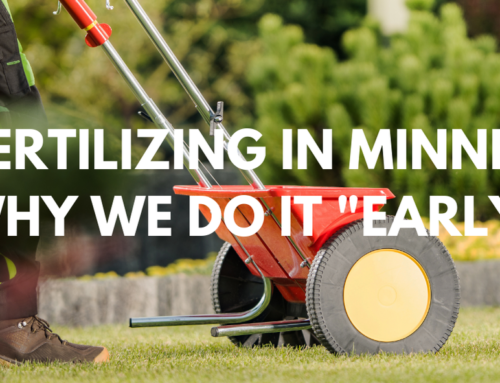Dormant Seeding: The Last Essential Lawn Care Task Before Winter
As the cold weather sets in and you finish up your fall lawn care chores, there is one last task you may want to consider—dormant seeding. This method involves sowing grass seed in late fall, allowing it to lie dormant through the winter before sprouting in early spring. If you missed the optimal seeding window earlier in the season, dormant seeding is a great way to set your lawn up for success next year.
Why Consider Dormant Seeding?
Dormant seeding helps improve bare or thin areas of your lawn by taking advantage of the natural winter cycle. By sowing seed after the ground has cooled (soil temperatures should drop below 50°F), the seed stays inactive through the cold months and begins germinating as soon as the soil warms up in the spring. This practice not only saves time but also allows the new grass to take root early, giving it a head start before the heat of summer hits.
As Sam Bauer- UMN Turf Specialist, put it, “If you haven’t kept up with watering during the fall drought, you are right to expect the worst next spring. A fall dormant seeding might help you sleep better during the winter, knowing that your lawn has seed ready to start growing next spring.”
ProLawns’ Dormant Seeding Service
Even though it’s been a dry fall, you can still improve your lawn for next spring! Overseeding now with the dormant seeding method will help fill in bare spots and thicken your lawn. In early to mid-November, when the ground is cold but not frozen, we’ll aerate your lawn with our special low-pressure aerator and overseed at the same time. This process ensures excellent seed-to-soil contact for optimal germination come spring. No watering or fertilizer is needed until then! If you prefer to DIY, see the next section.
The Dormant Seeding Process (for the DIY’er)
While the timing for dormant seeding is unique, the preparation steps are similar to regular seeding practices. Here’s how to go about it:
- Select the Right Seed
Choose a grass seed mix suited to your lawn’s conditions. For sunny spots, a mix containing Kentucky bluegrass and fine fescue is ideal. If you’re seeding shaded areas, look for shade-tolerant varieties like fine fescues. Use about 3 to 4 pounds of seed per 1,000 square feet for optimal results. - Prepare the Soil
To ensure good seed-to-soil contact, it’s essential to loosen the top layer of soil. Small areas can be prepared with a hand rake, while larger areas may benefit from using a power rake or vertical mower. These tools help remove plant debris and create tiny grooves in the soil where the seed can settle. - Apply the Seed
Spread the seed evenly across the prepared area using a spreader or by hand. Lightly rake or roll the soil afterward to ensure the seed is incorporated into the top quarter-inch of soil. - Wait for Spring
Once the seed is down, there’s little to do until spring. Be patient and avoid disturbing the area, as the seeds will need time to germinate once temperatures rise.
What to Expect in Spring
When spring arrives, your dormant-seeded lawn should begin to sprout. Soil temperatures need to rise above 50°F for germination to occur, and air temperatures should be above 60°F. Depending on the grass species, it may take 10 to 14 days for the grass to sprout, so give it time before considering any reseeding.
Bob Mugaas from the University of Minnesota Extension adds, “You shouldn’t necessarily feel your fall efforts were a failure if the lawn looks thin in the spring. Some additional overseeding may be necessary.”
By taking the time to dormant seed now, you’ll give your lawn a head start next year—helping it grow thicker and healthier before the harsh summer conditions set in.
For more details on the benefits of dormant seeding and expert tips on the process, check out this article by Sam Bauer: Dormant Seeding Your Lawn This Fall.





